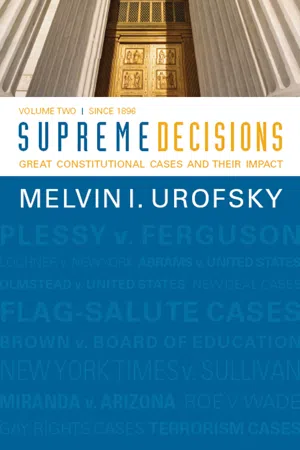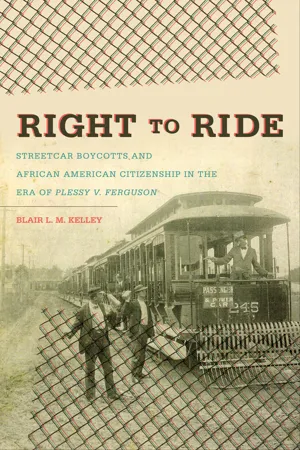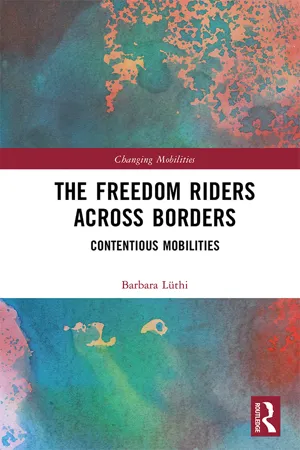History
Separate Car Act
The Separate Car Act was a law passed in the southern United States during the late 19th century that mandated racial segregation on trains. It required separate accommodations for white and black passengers, reflecting the era's widespread discrimination and segregation laws. The act was a significant part of the Jim Crow laws that enforced racial segregation in public facilities.
Written by Perlego with AI-assistance
Related key terms
Related key terms
1 of 4
Related key terms
1 of 3
4 Key excerpts on "Separate Car Act"
- eBook - ePub
Supreme Decisions, Volume 2
Great Constitutional Cases and Their Impact, Volume Two: Since 1896
- Melvin I. Urofsky(Author)
- 2018(Publication Date)
- Routledge(Publisher)
But although the practices of segregation may have been inconsistent, the white South stood united in the belief that blacks belonged in a secondary status in society, in which they could not exercise political power and would not threaten the social hegemony of whites. Some historians have seen the beginnings of segregation on public transportation, such as steamboats and railroads, as at least in part gender-based. White women had always enjoyed separate first-class train accommodations, so they could be insulated against the crudeness of the men’s smoking car, lower-class whites, and of course slaves and other African Americans, except those who traveled with their mistresses as maids or nannies. The men’s equivalent had been the first-class smoking car, with its bar and spittoons. When freed blacks attempted to buy tickets for these cars, the railroads, sensitive to the patronage and power of their white clients, refused.In 1878, the Supreme Court in Hall v. DeCuir ruled that states could not prohibit segregation on common carriers such as railroads, streetcars, or riverboats. A dozen years later it approved a Mississippi statute requiring segregation on intrastate carriers in Louisville, New Orleans & Texas Railway v. Mississippi (1890). In doing so the Court essentially acquiesced in the South’s solution to the problems of race relations. Only Justices Harlan and Bradley dissented, on the grounds that such laws, even if confined to intrastate lines, had an inhibitive effect on interstate commerce.From 1887 to 1892 nine states, including Louisiana, passed laws requiring separation on public conveyances, such as streetcars and railroads. Though they differed in detail, most of these statutes required equal accommodations for black passengers, and imposed fines and even jail terms on railroad employees who did not enforce these regulations. Five of the states also provided criminal fines or imprisonment for passengers who tried to sit in cars from which their race excluded them. The Louisiana Separate Car Act passed in July 1890. In order to “promote the comfort of passengers,” railroads had to provide “equal but separate accommodations for the white and colored races” on lines running in the state. - eBook - ePub
The Era of Jim Crow
Segregation and White Supremacy
- Tim McNeese(Author)
- 2021(Publication Date)
- Chelsea House(Publisher)
In the United States of 1896, few cared whether the court upheld a single “Jim Crow” law. In the issue published the day after the decision, the New York Times reported the story on page three of its second section alongside other run-of-the-mill railroad-related stories. The Times noted Justice Harlan’s solo rejection of the arguments in favor of the Separate Car Law, observing how “he saw nothing but mischief in such laws.” 15 The New Orleans newspaper, the Daily Picayune, praised the court’s decision and expressed support for the Separate Car Law, anticipating that “this regulation for the separation of the races will operate continuously on all lines of Southern railway.” 16 In Richmond, Virginia, the Dispatch pondered, given the now-sanctioned Louisiana Separate Car Law, “whether such a law as that of Louisiana is not needed in all the Southern States.” 17 Even most Northern papers did not raise any significant issue with the Supreme Court’s decision. But at least the Springfield, Massachusetts, Republican asked an inconvenient question, mocking the court’s decision to maintain “separate but equal” to keep the races apart: “Did the southerners ever pause to indict the Almighty for allowing Negroes to be born on the same earth with white men?” 18 The Spread of Jim Crow Laws With the United States Supreme Court declaring the concept of “separate but equal” as an acceptable legal tenet, Jim Crow laws spread into more and more areas of African-American life. Eight Southern states, including Louisiana, had created separate car laws prior to Plessy boarding his “test case” train outside New Orleans in 1892, the others being Alabama, Florida, Georgia, Kentucky, Mississippi, Tennessee, and Texas. Following Plessy v. Ferguson, others added their own versions: South Carolina in 1898; North Carolina the following year; Virginia in 1900; Maryland in 1904; and Oklahoma in 1907. New Jim Crow laws filled the statute books - eBook - ePub
The John Hope Franklin Series in African American History and Culture
Streetcar Boycotts and African American Citizenship in the Era of Plessy v. Ferguson
- Blair L. M. Kelley(Author)
- 2010(Publication Date)
- The University of North Carolina Press(Publisher)
In 1890, a push for new segregation laws also began in Kentucky, a slave state that had not seceded during the Civil War. The state’s pro-Union stance did not prevent the demand, particularly among rural white Kentuckians, to prevent blacks from riding first class on the train. In December 1891, state senator Tipton Miller from rural Calloway County proposed a new law in December 1891 resembled the 1889 Mississippi law upheld by the Supreme Court and required railroads “to furnish separate coaches or cars for the travel or transportation of the white and colored passengers.” 66 It detailed an efficient and cost-effective means for dividing passengers that left blacks jammed in a smoky, uncomfortable space adjoining a polluted smoking car marked with “appropriate words in plain letters indicating the race for which it is set apart.” Any black passenger who complained would face legally enforced ejection. The law gave the conductor the “right to refuse to carry such passenger on his train” and to “put such passenger off of the train.” Any official who refused to comply was subject to a fine ranging from five hundred to fifteen hundred dollars for each violation. In response, a group of black educators, ministers, and businesspeople from Kentucky organized the anti-separate-coach movement. 67 Black citizens from throughout Kentucky attempted to halt the passage of the separate coach law, organizing mass meetings, drawing up protest documents, and presenting hundreds of resolutions of protest and petitions to the governor and state legislators - eBook - ePub
The Freedom Riders Across Borders
Contentious Mobilities
- Barbara Lüthi(Author)
- 2022(Publication Date)
- Routledge(Publisher)
Seiler 2006, 1093 ) for African Americans.In 1961 the Congress of Racial Equality (CORE), under its new national director, James Farmer, came up with the idea to put Blacks and whites from all walks of life in small groups on commercial buses, which would deliberately violate the segregation laws of the Deep South.13 Grounded in the Gandhian tradition of non-violence, the Freedom Riders would test compliance with two Supreme Court decisions mandating desegregation of interstate travel, Morgan v. Commonwealth of Virginia (1946 ) and Boynton v. Virginia (1960).Whereas human movement is made meaningful in specific social and cultural contexts (Cresswell 2006 , 150), law represents one of the most powerful technologies to regulate the right to mobility. It can elucidate how mobility as movement is embedded within specific power structures. Laws regulating interstate travel and public space have only been one of the few examples of how African Americans were pushed into “cramped spaces.” In understanding law from a cultural perspective, one important question is how law is put into practice in everyday life (Siemens 2012 ). In the struggle for the civil rights of African Americans, laws became all the more important for interstate travel on buses because, as Herman Long stated in 1954,[w]herever a policy, law, or a set of administrative regulations is so loosely constructed that it is at the mercy of local custom, or what may be termed the ‘racial behavior code’, they will in turn be compromised and diverted to the arbitrary demands of local practice. Bus transportation seems best as an illustration of this, for regardless of the interstate character of a given trip, the bus, with its frequent stops in small towns and rural areas, is more a part of the local scene than other modes of interstate transport. And it appears generally the case that bus regulations regarding the servicing of Negro passengers are more loosely drawn and more arbitrarily administered. At the same time, the demand for the appropriated and expected forms of racial behavior is greater.
Index pages curate the most relevant extracts from our library of academic textbooks. They’ve been created using an in-house natural language model (NLM), each adding context and meaning to key research topics.
Explore more topic indexes
Explore more topic indexes
1 of 6
Explore more topic indexes
1 of 4



